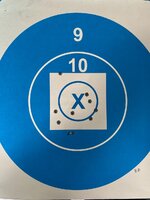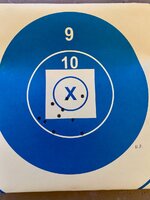So conditions can hold for 5 shots or 1 shots, but not more? Then why not just measure two shot groups?
Remove bench rest. How does “tuning” loads work for actual field rifles? You tune a load, go on a couple week hunt, shoot a few rounds to check zero- and then what? Load inside the tent to “re tune” it? Field rifles have to remain static for hundreds of rounds at a minimum- or at least any field rifle I’m going to use must.
The 308 that I spoke about in my last post remained statistically stable from 100’ish rounds in the barrel to over 8,000 rounds of the same lot of ammo. With no cleaning ever. The last match I used it in with that load- it won Witt almsot 14,000 rounds on it. Though it had opened a bit.
That literally makes no logical sense. Indoor ranges remove variables- to only measure the gun and ammo precision.
At long range it can be iffy for conditions to hold for 10-shots. Sometimes they do, as the targets I posted show. Conditions are much more likely to hold for five, but I have even seen conditions go away during a five-shot string. When I am sighting in a hunting rifle prior to hunting, I shoot two shots from a dead cold barrel, then let the barrel cool completely before shooting again. That's most simulates what I'll be doing in the field. We should train like we fight.................
Tuning loads for field rifle works the same way as it does for BR rifles. We find the best and most consistent load we can, then go hunt. There is often a difference between the load that gives the smallest group vs the most forgiving load. I load hunting rifles to be forgiving. If a rifle produces .3, .8, .5, .5; I am going to pick the more forgiving node of .5 and .5. It has the widest window where it will still shoot well. We usually pick forgiving loads for LRBR as well.
I never trust a single group 100 yd group as being meaningful. It has to repeat, preferably at a little longer range like at least 300 yds. That said, I have had more than one hunting rifle shoot a .3 at 100 and back it up with a 1 to 1.2 at 300 yds.
About the only hunting rifle that needs to remain static for hundreds of rounds is a varmint rifle. For a big game rifle, which is what I expect most here are interested in, we rarely need anywhere near 100 shots. What it comes down to is what level of accuracy we want and for how long? If I want a load that is likely to stay in tune for a long time, I'll seat the bullets .090 - .150 off the lands. It may not shoot the tightest, but it will likely stay in tune for a long time.
In non-precision shooting disciplines, and there are a bunch--most in fact, we don't need to try and maintain the type of accuracy a BR rifles needs. So its more forgiving as to accuracy robbing practices like not cleaning or never readjusting the load. Most big game type rifles will go at least 50-100 rounds between cleaning before accuracy falls off. Some will go longer. Same for LRBR rifles. Short range guys clean like every 20 rounds.
I got my azz chewed at a match last year by my fellow competitors for not cleaning. It was the same match that I shot the 4.3 and 3.8 that I posted pics of. I wanted to see how it would shoot without cleaning. My lasy group opened up to a 9. They basically said it was stupid of me to push a 300 WSM that far during a match. Turns out that barrel shot well to around 75 rounds, then would fall off. Of course, if I only cared about 1 MOA 1000 yd 10-shot groups, no cleaning was needed.
An LRBR barrel in 6BRA/6Dasher or 300 SAUM IMP/300 WSM will maintain BR level accuracy for 1000-1500 rounds, depending. When the conditions are poor, guys with less well tuned rifles can compete with the top shooters, because the conditions so overwhelm everything else. However, when the conditions are good, we see who knows how to tune their rifle.
Indoor ranges remove the very variables we need to tune for when outside. We will miss things that show up outside. We need loads that will better shoot through condition changes, and the only way to find that is to tune our loads in conditions. Now we do try to find the best conditions, but there is a huge difference between tuning outside in good conditions at 1000 yds vs shooting 100 rounds indoors at 100 yds in terms of useful info.
Further, tuning at 100 yds doesn't lead to the best accuracy unless we are competing at 100 yds. The best practice is to tune at the distance we want to shoot. The boys I shoot 1k BR with held a 2000 yd BR match a couple years ago. Now most of these guys did their tuning at 1000 yds. I would expect these loads would shoot 2-5" 5-shot groups at 1000, depending on conditions. These guys shot like 20-30" groups at 2000. All except one. He actually tuned his rifle at 2000 yds, and he shot like 12" and 15" groups.
For me personally, I have occasionally seen where a 200-300 yd load would shoot well at 1000. Most of the time it doesn't. What I have seen most often is that at short range ,the lower node often shoots best. At 1000 yds the higher node shoots best. The only way to know is to test at 1000 yds. The only useful info I get at short range for my LRBR rifles is to identify the nodes. Then I load up ladders around those nodes and test using the round-robin tuning method at 1000 yds.


